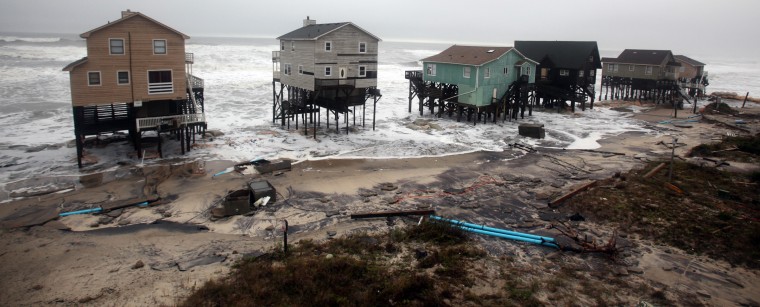The owner of [oceanfront] land loses title to such portions as are so worn or washed away or encroached upon by the water. Thus, the lots of the plaintiff were gradually worn away by the churning of the ocean on the shore and thereby lost. Its title was divested by “the sledge hammering seas, the inscrutable tides of God.” North Carolina Supreme Court (quoting Moby Dick) in Carolina Beach Fishing Pier, Inc. v. Town of Carolina Beach (1970).
A lot in Raleigh or Asheville (or most points in between) can be expected to stay within the lot lines on a survey, but oceanfront property has at least one movable boundary – the Atlantic Ocean. If beach erosion causes the mean high water line to move toward land, the property boundary moves with it. Any area seaward of the new mean high water line becomes state-owned “public trust” land. The idea of the sovereign — in this case the state — holding all lands under navigable waters in trust for the people came to the American colonies from British law and has been adopted in some form by every coastal state. North Carolina public trust law recognizes a public right to use the ocean waters and the beach strand — roughly the area between the daily low tide line and the dunes — for swimming, navigation, fishing and recreation. As the Atlantic Ocean reshapes the North Carolina coast, the moving boundary may cause private property to become public trust property. There are areas of the North Carolina coast where entire rows of undeveloped lots have disappeared into the Atlantic Ocean to become public trust lands.
South Nags Head 2009 (Photo: The Virginian Pilot)
The last two sections of Senate Bill 151 (Coastal Policy Reform Act of 2013) address the problem of damaged structures on the public beach or in public trust waters. Since flood insurance only covers damage by flooding, an oceanfront property owner has an incentive to allow an uninhabitable erosion-damaged house to stay on the beach (or in the water) until it finally collapses during a storm. In the meantime, the damaged structure can be both an obstruction and a safety hazard. Senate Bill 151 responds to a 2012 N.C. Court of Appeals decision, Town of Nags Head v. Cherry, Inc., by giving coastal towns and counties clear authority to take legal action to remove nuisance structures from public trust areas.
The decision in Town of Nags Head v. Cherry, Inc. came out of the town’s efforts to remove an oceanfront house under a local nuisance ordinance specifically written to deal with storm and erosion-damaged structures. The Nags Head ordinance requires removal of a damaged structure if it creates a likelihood of injury to people or property or if the structure (whatever its condition) is located in a public trust area or on public land. The house owned by Cherry, Inc. had some structural damage, but the more significant problem was that erosion had left the house seaward of the high water line. Utility connections had been cut because waves washed under the structure. The septic tank and drain lines had been damaged and were partially exposed on the beach, leaving the house with no sanitation system.
The Court of Appeals concluded that the Town of Nags Head did not provide enough evidence that the house created a risk of injury to people or property and sent that issue back to the trial court for hearing. Having set aside the injury issue, the court then held that the town could not use the nuisance ordinance to order removal of the house just because it obstructed the public trust area. The court held that only the State of North Carolina (through the Attorney General) can enforce public trust rights.
The most basic problem with the Cherry, Inc. decision is that the court lost sight of the fact that an oceanfront structure exists in an environment very different from a house in Raleigh or Asheville. The court interpreted the Nags Head decision to order removal rather than repair of the house as evidence that the town acted only because the house obstructed the public trust area — and not because the house posed an actual risk to people or property. As the court said: ” If the Dwelling was a nuisance because of its location in a public trust area, then the only way to abate the nuisance would be removal of the Dwelling, while conditions such as damage to the Dwelling could likely be repaired.”
By separating the location of the house from the assessment of risk to people and property, the court overlooked the fact that a damaged structure in the surf zone of the Atlantic Ocean may not be repairable in the usual sense. A house buffeted by daily tides and vulnerable to every storm is at risk of collapse — endangering beachgoers and leaving dangerous debris — even if the house itself is intact. The Cherry, Inc. house had also lost its septic system. Replacing a septic system on a lot overwashed by the tides creates a source of contamination in an area used by the public for swimming and sunbathing. Given continuing erosion and the power of the tides, replacement of the septic system would likely also be futile.
As a practical matter, the Cherry, Inc. decision would require the Attorney General to address nuisance conditions on the ocean beach or in the surf zone even though a town or county already has police power jurisdiction over the area. Senate Bill 151 would restore local government authority to consider both condition and location in deciding that a storm or erosion-damaged structure is a public nuisance that must be removed.

